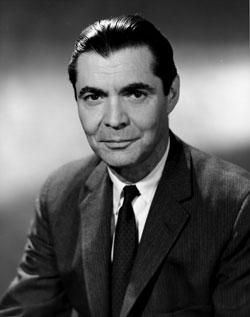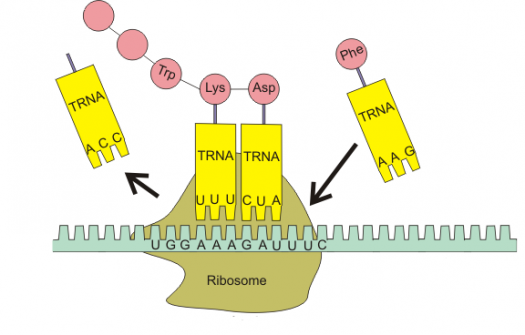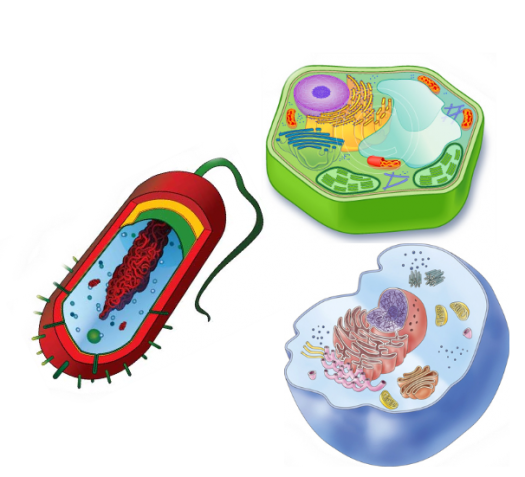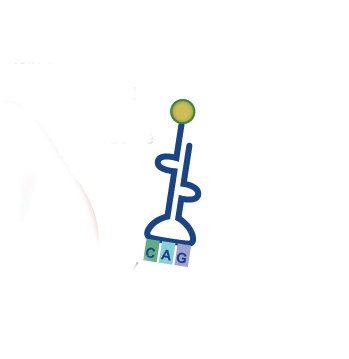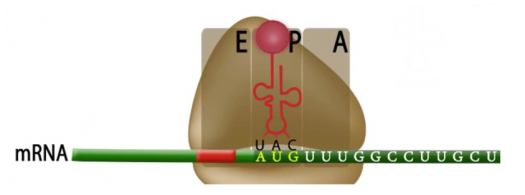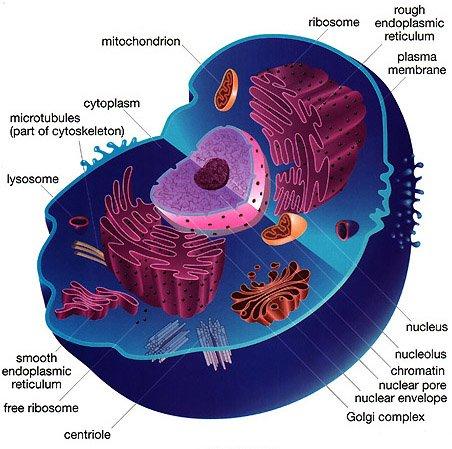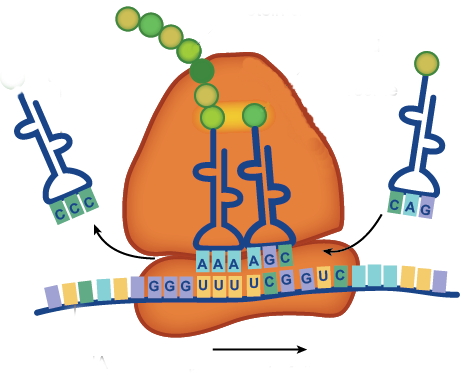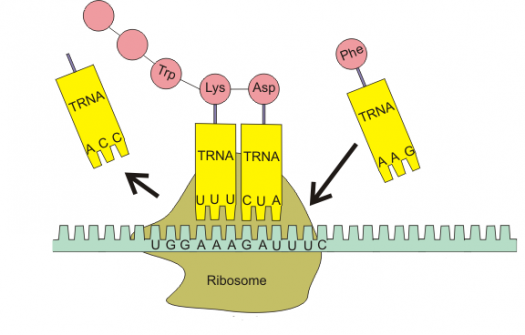Ribosomes

- 1.
Who first discovered ribosomes?
- A.
Robert Hooke
- B.
Antonie van Leeuwenhoek
- C.
George Emil Palade
- D.
Theodor Schwann
Correct Answer
C. George Emil PaladeExplanation
George Emil Palade is credited with the discovery of ribosomes. He was a Romanian-American cell biologist who conducted extensive research on the structure and function of cells. In the 1950s, Palade used an electron microscope to observe cellular structures and identified ribosomes as small particles attached to the endoplasmic reticulum. His discovery of ribosomes and their role in protein synthesis revolutionized our understanding of cellular biology.Rate this question:
-
- 2.
Where are ribosomes found in a cell?
- A.
Smooth ER
- B.
Rough ER
- C.
Mitochondria
- D.
Centrioles
- E.
Chloroplast
- F.
Vacuole
- G.
Free floating in cytosol
Correct Answer(s)
B. Rough ER
C. Mitochondria
E. Chloroplast
G. Free floating in cytosolExplanation
Ribosomes are found in multiple locations within a cell. They can be free-floating in the cytosol, attached to the rough endoplasmic reticulum (ER), or located within mitochondria and chloroplasts. Ribosomes are responsible for protein synthesis, and their presence in these different locations allows for the production of proteins both for use within the cell and for export outside of the cell.Rate this question:
-
- 3.
What is the main function of a ribosome?
Correct Answer(s)
make protein, make proteins, to make proteins, to make protein, to perform protein synthesis, perform protein synthesis, Protein synthesisExplanation
The main function of a ribosome is to make proteins through a process called protein synthesis. Ribosomes are responsible for reading the genetic information in mRNA molecules and using it to assemble amino acids into a chain, which then folds into a functional protein. This process is essential for the functioning and survival of cells, as proteins are involved in almost all cellular processes and perform a wide range of functions.Rate this question:
- 4.
What kinds of cells are ribosomes found in?
- A.
Eukaryotic
- B.
Prokaryotic
- C.
Both
Correct Answer
C. BothExplanation
Ribosomes are found in both eukaryotic and prokaryotic cells. Eukaryotic cells, which include animal and plant cells, have membrane-bound organelles, including the nucleus where DNA is housed. Ribosomes in eukaryotic cells are primarily located in the cytoplasm and on the rough endoplasmic reticulum. Prokaryotic cells, such as bacteria, do not have a nucleus or membrane-bound organelles. In prokaryotes, ribosomes are found freely floating in the cytoplasm. Therefore, ribosomes are present in both types of cells.Rate this question:
-
- 5.
What is the function of tRNA?
- A.
To carry genetic info from nucleus
- B.
To make up a ribosome
- C.
To carry amino acids to the ribosome
- D.
To carry lipids to the ribosome
Correct Answer
C. To carry amino acids to the ribosomeExplanation
tRNA, or transfer RNA, is responsible for carrying amino acids to the ribosome during protein synthesis. It binds to specific amino acids and transports them to the ribosome, where they are then incorporated into the growing polypeptide chain. This process ensures that the correct sequence of amino acids is added to the protein being synthesized. Therefore, the function of tRNA is to carry amino acids to the ribosome.Rate this question:
-
- 6.
Proteins produced in rough endoplasmic reticulum are exported out of the cell, while proteins produced in the cytosol are used in the cell.
- A.
True
- B.
False
Correct Answer
A. TrueExplanation
Proteins produced in the rough endoplasmic reticulum (ER) are exported out of the cell because the rough ER is involved in protein synthesis and modification. It has ribosomes attached to its surface, which produce proteins that are destined for secretion or for use in the cell membrane. These proteins are synthesized into the lumen of the ER, where they undergo folding and post-translational modifications. On the other hand, proteins produced in the cytosol are generally used within the cell for various functions such as enzymatic activity, structural support, or signaling. Therefore, the statement that proteins produced in the rough ER are exported out of the cell, while proteins produced in the cytosol are used in the cell, is true.Rate this question:
-
- 7.
At which site (A site, P site, or E site) does the tRNA carry the polypeptide chain?
- A.
A
- B.
P
- C.
E
Correct Answer
B. PExplanation
The tRNA carries the polypeptide chain at the P site. The P site is one of the three sites on the ribosome where tRNA molecules bind during protein synthesis. The P site stands for the peptidyl site, and it is where the growing polypeptide chain is held by the tRNA molecule. The tRNA at the P site transfers the polypeptide chain to the incoming amino acid on the tRNA at the A site, allowing for the elongation of the protein chain.Rate this question:
-
- 8.
Where are ribosomes produced in eukaryotic cells?
- A.
Nucleolus
- B.
Endoplasmic Reticulum
- C.
Cytosol
- D.
Mitochondria
Correct Answer
A. NucleolusExplanation
Ribosomes are produced in the nucleolus of eukaryotic cells. The nucleolus is a distinct region within the nucleus where ribosomal RNA (rRNA) is synthesized and combined with proteins to form ribosomes. These ribosomes are then transported to the cytosol, where they carry out protein synthesis. The endoplasmic reticulum and mitochondria are involved in other cellular processes but not in the production of ribosomes.Rate this question:
-
- 9.
Ribosomes are made up of ________________________.
Correct Answer
proteins and rRNA, rRNA and proteins, protein and rRNA, rRNA and proteinExplanation
Ribosomes are composed of both proteins and rRNA (ribosomal RNA). These two components work together to form the structure and function of ribosomes. Proteins make up the majority of the ribosome, providing structural support and facilitating the binding of mRNA (messenger RNA) and tRNA (transfer RNA). On the other hand, rRNA plays a crucial role in catalyzing the formation of peptide bonds during protein synthesis. Therefore, ribosomes consist of proteins and rRNA, with both components being essential for their proper functioning.Rate this question:
- 10.
Where are codons found?
- A.
On amino acids
- B.
On tRNA
- C.
On the mRNA strand
- D.
In endoplasmic reticulum
Correct Answer
C. On the mRNA strandExplanation
Codons are sequences of three nucleotides found on the mRNA strand. These codons are responsible for encoding the specific amino acids that will be incorporated into a growing protein chain during the process of translation. Each codon corresponds to a specific amino acid or a stop signal, providing the instructions for the order and composition of the protein. Therefore, the correct answer is that codons are found on the mRNA strand.Rate this question:
-
- 11.
BONUS! What monomer are codons and anticodons made of? Hint: Where does RNA (tRNA or mRNA), containing codons and anticodons, come from? Which macromolecule had bases which we learned the letters of?
Correct Answer
nucleotides, nucleotideExplanation
Codons and anticodons are made up of nucleotides, which are the monomers of nucleic acids. RNA, including mRNA and tRNA, is synthesized from nucleotides. The bases in nucleotides, such as adenine, cytosine, guanine, and uracil, are the letters of the genetic code that determine the sequence of codons and anticodons. Therefore, the correct answer is nucleotides, specifically nucleotide monomers.Rate this question:
Quiz Review Timeline +
Our quizzes are rigorously reviewed, monitored and continuously updated by our expert board to maintain accuracy, relevance, and timeliness.
-
Current Version
-
Jan 07, 2024Quiz Edited by
ProProfs Editorial Team -
Dec 21, 2015Quiz Created by
Jennywang2019



